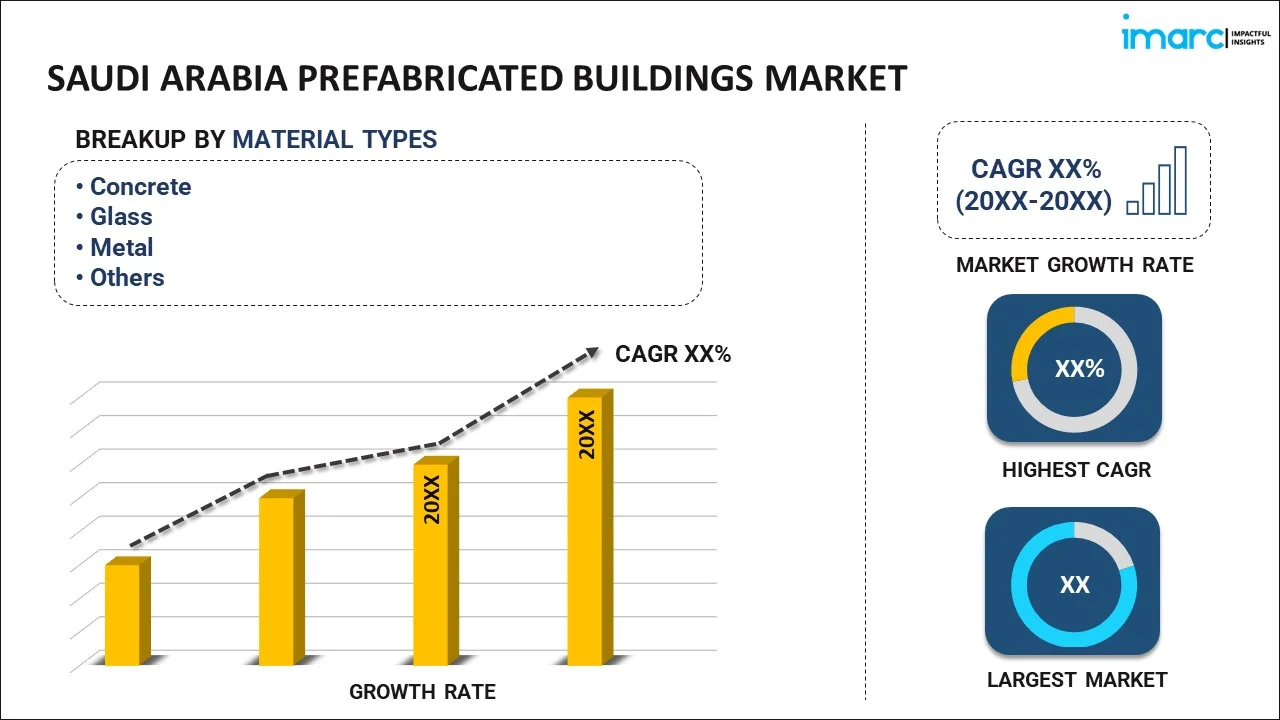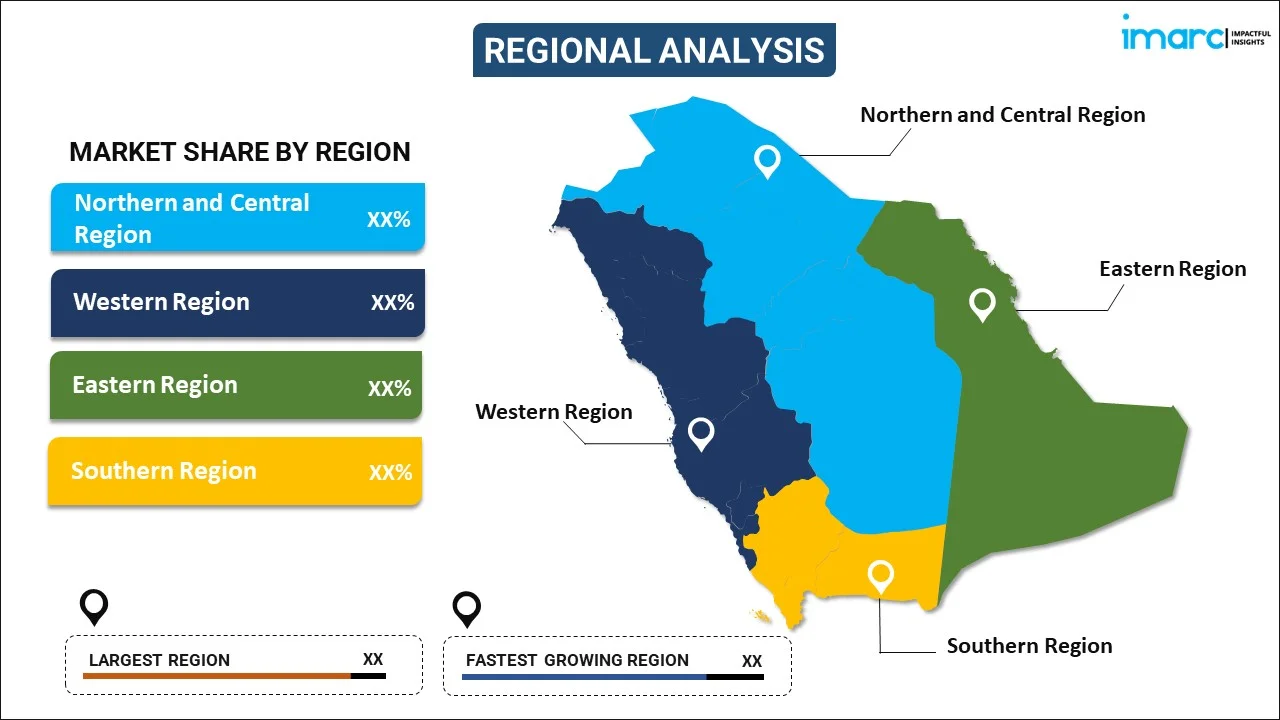
Saudi Arabia Prefabricated Buildings Market Report by Material Type (Concrete, Glass, Metal, Timber, and Others), Application (Residential, Commercial, and Others), and Region 2026-2034
Market Overview:
Saudi Arabia prefabricated buildings market size reached USD 1.4 Billion in 2025. Looking forward, IMARC Group expects the market to reach USD 2.3 Billion by 2034, exhibiting a growth rate (CAGR) of 5.80% during 2026-2034. The expanding construction industry, along with the evolving infrastructure and housing needs, is primarily driving the market growth.
|
Report Attribute
|
Key Statistics
|
|---|---|
|
Base Year
|
2025
|
|
Forecast Years
|
2026-2034
|
|
Historical Years
|
2020-2025
|
|
Market Size in 2025
|
USD 1.4 Billion |
|
Market Forecast in 2034
|
USD 2.3 Billion |
| Market Growth Rate 2026-2034 | 5.80% |
Prefabricated buildings, often referred to as prefab or modular buildings, are structures that are manufactured off-site in sections or modules and then transported to the construction site for assembly. These buildings are designed and constructed in a controlled factory environment, where they undergo precise engineering and quality control processes. Prefabrication involves the manufacturing of building components, including walls, floors, roofs, and even entire rooms or modules, which are then transported to the site and assembled into the final structure. Prefabricated buildings offer several advantages, including faster construction times, reduced waste, cost efficiency, and versatility in design. They can be used for a wide range of purposes, from residential homes and office buildings to schools, hospitals, and industrial facilities. Prefabricated construction techniques have gained popularity due to their ability to accelerate project timelines while maintaining quality and sustainability standards.
Saudi Arabia Prefabricated Buildings Market Trends:
Rising Demand for Cost-Effective Construction Solutions
Conventional construction techniques frequently lead to elevated material and labor expenses, causing extended project durations and higher total costs. However, modular structures offer a budget-friendly option by greatly shortening the time needed for construction and decreasing labor demands. The modular structure of prefabricated buildings enables effective mass production in factory environments, consequently lowering the expenses related to on-site labor and material sourcing. Moreover, prefabricated structures are usually more energy-efficient in the construction phase, producing less waste and allowing for improved material use. This aspect of sustainability increases their economic attractiveness as developers can reduce their environmental footprint and material expenses. With the growing focus of the construction sector on managing expenses while ensuring quality, prefabricated structures present a viable, cost-effective option for extensive projects, appealing to both public and private developers throughout the Kingdom.
Increasing Focus on Time-Efficient Construction
The need for faster building schedules is gaining significance in Saudi Arabia, especially as extensive infrastructure projects keep growing. Conventional building techniques frequently take a long time, necessitating intricate, on-location procedures like thorough planning, material transport, and physical work. This may result in considerable project holdups and prolonged schedules. In contrast, modular buildings provide a significant time benefit by enabling much of the assembly to occur off-site in regulated factory settings. The modular design of these structures allows for concurrent site preparation and manufacturing, decreasing total construction duration. Prefabricated buildings can be provided in a ready-to-assemble state, which greatly reduces the construction timeline. This addresses the increasing need for quicker project completion and also aids in reducing delays caused by weather issues, workforce shortages, or other unexpected circumstances. The capability to finalize projects more quickly, while upholding excellent quality standards, is a key reason for the growing appeal of prefabricated structures in Saudi Arabia's rapid construction industry.
Government-Led Infrastructure and Economic Diversification Plans
Saudi Arabia's emphasis on infrastructure enhancement and economic diversification is propelling the growth of the market. In 2024, the governing body dedicated $2.66 billion for the creation of 18 new logistics zones, an important move to position the Kingdom as a worldwide logistics center. This effort was a part of a larger strategy to increase the overall number of logistics zones to 59 by 2030, designed to improve Saudi Arabia’s standing in global trade and logistics. The swift growth of these logistics areas requires efficient, economical construction options, making prefabricated structures ideal option because of its fast assembly and adaptability. With Saudi Arabia's ongoing efforts to diversify its economy, especially through the growth of non-oil sectors, the demand for contemporary, effective construction techniques is increasing. With their rapid construction and adaptability, prefabricated structures are becoming vital in fulfilling infrastructure needs, contributing to the market growth in Saudi Arabia.
Saudi Arabia Prefabricated Buildings Market Growth Drivers:
Technological Advancements in Construction Methods
Advancements in 3D printing, automated manufacturing, and building information modeling (BIM) are improving the design and manufacturing techniques of prefabricated structures. These technologies improve precision, minimize mistakes, and guarantee superior quality management throughout the construction process. BIM, for instance, enables accurate digital models that enhance resource management and optimize project timelines. Automated production methods facilitate quicker manufacturing periods while maintaining high uniformity in material quality. The combination of these technologies enhances the development of extensive, intricate structures and infrastructure more efficiently. With the rising demand for fast and effective construction methods, especially in the Kingdom’s infrastructure initiatives, advanced prefabrication techniques are becoming vital for addressing the changing construction requirements, ensuring timely project completion.
Rise of Major Mega Projects and Smart Cities
Saudi Arabia's dedication to extensive mega projects and the advancement of smart cities is a significant factor influencing the prefabricated buildings market. These projects require rapid construction schedules and compliance with high design and performance criteria. Prefabrication technique enables quicker assembly while upholding the high-quality benchmarks needed for these ambitious projects. A significant instance is the 2024 launch of the $1.6 billion "Heart of Khobar" smart city project, a 268,000 sqm multipurpose development. It included hotels, offices, retail centers, parks, theaters, and plenty of parking areas, all constructed with an emphasis on sustainability and modern infrastructure. Employing prefabricated building techniques enables developers to satisfy the tight deadlines and high-quality standards for these innovative projects. Projects such as NEOM and the Heart of Khobar demonstrate that prefabricated buildings are an excellent choice for quickly advancing infrastructure, delivering flexibility, sustainability, and efficiency in the construction of smart cities.
Growing Demand from Educational and Healthcare Infrastructure Projects
The emphasis on enhancing public services in Saudi Arabia, especially via public-private partnerships (PPP), is driving the need for swift, affordable construction methods. In 2024, the conclusion of the initial phase of the Wave 2 PPP Education program, which included the establishment of 60 new schools in Medina, underscored the necessity for effective, expandable construction techniques. Prefabricated structures are an excellent option for large-scale, urgent projects because they can be constructed rapidly and economically. With the ongoing growth of healthcare and education sectors, driven by significant investments in infrastructure for the Kingdom's increasing population, the need for prefabricated construction technique is growing. This approach coincides with Saudi Arabia's larger development objectives, offering a way to address both financial limitations and strict project deadlines. The continuous growth of these sectors guarantees that prefabricated construction will be crucial to the Kingdom's initiatives for improving public services and promoting sustainable development.
Saudi Arabia Prefabricated Buildings Market Segmentation:
IMARC Group provides an analysis of the key trends in each segment of the market, along with forecasts at the country level for 2026-2034. Our report has categorized the market based on material type and application.
Material Type Insights:

To get more information on this market, Request Sample
- Concrete
- Glass
- Metal
- Timber
- Others
The report has provided a detailed breakup and analysis of the market based on the material type. This includes concrete, glass, metal, timber, and others.
Application Insights:
- Residential
- Commercial
- Others
A detailed breakup and analysis of the market based on the application have also been provided in the report. This includes residential, commercial, and others.
Regional Insights:

- Northern and Central Region
- Western Region
- Eastern Region
- Southern Region
The report has also provided a comprehensive analysis of all the major regional markets, which include Northern and Central Region, Western Region, Eastern Region, and Southern Region.
Competitive Landscape:
The market research report has also provided a comprehensive analysis of the competitive landscape in the market. Competitive analysis such as market structure, key player positioning, top winning strategies, competitive dashboard, and company evaluation quadrant has been covered in the report. Also, detailed profiles of all major companies have been provided.
Saudi Arabia Prefabricated Buildings Market News:
- March 2025: China Harbour Engineering Company (CHEC) opened a 200,000 sqm modular manufacturing plant in northern Riyadh to supply prefabricated components for the Sedra housing project by Roshn (PIF). The facility uses advanced robotics and digital production systems to boost construction efficiency. It aligns with Saudi Vision 2030 to promote sustainable, affordable housing through modular building.
- January 2025: NMDC Energy inaugurated an AED 200 million fabrication yard in Saudi Arabia’s Ras Al Khair Special Economic Zone. Spanning 400,000 sqm, the facility will produce offshore structures and modular (prefabricated) onshore units with a 40,000-ton annual capacity. The project supports regional energy goals and promotes sustainable, high-tech construction.
Saudi Arabia Prefabricated Buildings Market Report Coverage:
| Report Features | Details |
|---|---|
| Base Year of the Analysis | 2025 |
| Historical Period | 2020-2025 |
| Forecast Period | 2026-2034 |
| Units | Billion USD |
| Scope of the Report | Exploration of Historical and Forecast Trends, Industry Catalysts and Challenges, Segment-Wise Historical and Predictive Market Assessment:
|
| Material Types Covered | Concrete, Glass, Metal, Timber, Others |
| Applications Covered | Residential, Commercial, Others. |
| Regions Covered | Northern and Central Region, Western Region, Eastern Region, Southern Region |
| Customization Scope | 10% Free Customization |
| Post-Sale Analyst Support | 10-12 Weeks |
| Delivery Format | PDF and Excel through Email (We can also provide the editable version of the report in PPT/Word format on special request) |
Key Benefits for Stakeholders:
- IMARC’s industry report offers a comprehensive quantitative analysis of various market segments, historical and current market trends, market forecasts, and dynamics of the Saudi Arabia prefabricated buildings market from 2020-2034.
- The research report provides the latest information on the market drivers, challenges, and opportunities in the Saudi Arabia prefabricated buildings market.
- Porter's five forces analysis assist stakeholders in assessing the impact of new entrants, competitive rivalry, supplier power, buyer power, and the threat of substitution. It helps stakeholders to analyze the level of competition within the Saudi Arabia prefabricated buildings industry and its attractiveness.
- Competitive landscape allows stakeholders to understand their competitive environment and provides an insight into the current positions of key players in the market.
Key Questions Answered in This Report
The prefabricated buildings market in Saudi Arabia was valued at USD 1.4 Billion in 2025.
The Saudi Arabia prefabricated buildings market is projected to exhibit a CAGR of 5.80% during 2026-2034, reaching a value of USD 2.3 Billion by 2034.
The Saudi Arabia prefabricated buildings market is driven by the growing demand for cost-effective, time-efficient construction solutions, advancements in construction technologies, and the need for sustainable building practices. Additionally, the increasing focus on urbanization, infrastructure development, and the government’s support for innovative building methods contribute to the market growth.
Need more help?
- Speak to our experienced analysts for insights on the current market scenarios.
- Include additional segments and countries to customize the report as per your requirement.
- Gain an unparalleled competitive advantage in your domain by understanding how to utilize the report and positively impacting your operations and revenue.
- For further assistance, please connect with our analysts.
 Request Customization
Request Customization
 Speak to an Analyst
Speak to an Analyst
 Request Brochure
Request Brochure
 Inquire Before Buying
Inquire Before Buying




.webp)




.webp)












